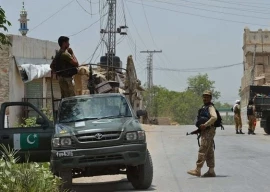
Only 65.2 per cent of households in Pakistan's ten major cities have access to piped water connections said the State of Pakistani Cities (SPC) report launched on Thursday.
The report presents the current state of development in the 10 largest cities of Pakistan and shed light on the state of economy, social service delivery, planning and development, housing, environment and heritage in the cities of Pakistan.
Funded by the Australian government, SPC report was spearheaded by the Ministry of Climate Change with the technical assistance of the United Nations Human Settlements Program (UN Habitat).
‘Only conservation can minimise water crisis’
It highlights the fundamental socio-economic drivers contributing to the local development needs of Pakistan.
The report says that cities lack sewage treatment facilities and solid waste management which leads to severe environmental pollution and contamination of surface and ground water bodies.
Shortage of power supply remains a persistent problem in harnessing the potential of the socio-economic development of the cities. The general understanding and appreciation of the environment and heritage is low among the relevant authorities and other stakeholders.
The report says that according to census 2017, around 75 million people live in urban areas and 54 per cent of the total urban population lives in 10 cities of the country. The report finds that larger cities have seen enormous urban sprawl due to increase in population and periphery areas are becoming extended part of the cities.
It further says that Pakistani cities vary in terms of their size, economy, employment and tax revenues. Services and industry are the major employment sectors in Pakistani cities. The share of the service economy in the cities is larger than the share of services in the national economy.
Pakistan generates 95 per cent of its total federal tax revenue from its 10 major cities and Karachi contributes 55 per cent, Islamabad 16 per cent, and Lahore 15 per cent. The average urban per capita income in Pakistan among the 10 cities varies from Rs37,000-70,000.
Poverty in urban areas is a major and visible phenomenon. Six out of the top 10 major cities have double-digit poverty figures: Quetta, with 46 per cent has the highest poverty rate while Islamabad with three per cent has the lowest.
The report reveals that increasing urbanisation has created pressing demands for housing in cities. The absence of any formal provision for the lower-income urban population and the people migrating from rural areas to urban areas has resulted in the creation of large informal settlements, lacking access to adequate level of services. The report also features data gap in the urban sector in Pakistan as one of the key limitation for sustainable development.
The report emphasises that Pakistani cities need to better plan and manage their development to meet the needs and demands of their citizens and indeed of the country. To prosper, cities need to be more responsive towards the environment and adopt technologies and economies that are less wasteful and destructive. Thus, taking a more realistic approach to development that meets the demands of the present without compromising the ability of future generations to meet their own needs.
Living by the sea, residents of NA-248 crave drinking water
Interim Federal Minister for Climate Change Yusuf Shaikh in his remarks reiterated commitment of the government to formulate the National and Provincial Urban Policies through participatory approach to arrive at viable solutions for climate resilient urban development in the country and support measures to implement SDG 11 for inclusive, safe, and resilient cities.
He said SPC report provides the basis for continued collaborative action to develop common and consistent actions, policies and strategies which will ensure that the outcomes are pragmatic and reflect the ground realities across the country.
Caretaker Minister for Planning, Development and Reforms Dr Shamshad Akhtar said that Pakistan was fortunate to have 31 per cent of its population consisting youth in age bracket of 15-29 years. “This youth bulge provides a unique opportunity for utilising their potential in contributing to urban economic development,” she said adding that value generated by the urban economy needs to be equally shared through innovative, integrated financial mechanisms to ensure sustainable flow of finance necessary for cities to meet the needs and provide opportunities for all. “Sustainable and inclusive urban economies can be created by promoting urban strategies and policies that strengthen the capacity of cities to realize full potential as drivers of socio-economic development,” Akhtar said.
The report launching ceremony was also attended by UN Resident Coordinator Neil Buhne, Australian High Commissioner, Margaret Adamson and other high level officials.
“Pakistan’s cities are growing fast. The great challenge is to keep them green, safe and liveable,” Adamson wrote on the micro-blogging site Twitter. “Today I helped launch the benchmark Australian-funded report ‘State of Pakistani Cities’ – an important contribution to policy making on this vital subject,” she tweeted.
Published in The Express Tribune, July 20th, 2018.
1719315628-0/BeFunky-collage-(8)1719315628-0-405x300.webp)


1731329418-0/BeFunky-collage-(39)1731329418-0-165x106.webp)




1731771315-0/images-(3)1731771315-0-270x192.webp)








COMMENTS
Comments are moderated and generally will be posted if they are on-topic and not abusive.
For more information, please see our Comments FAQ